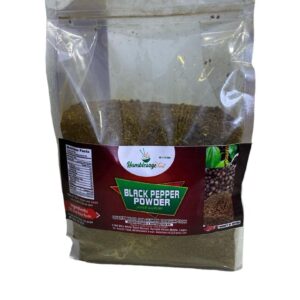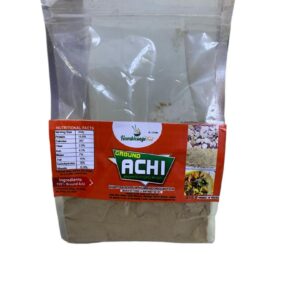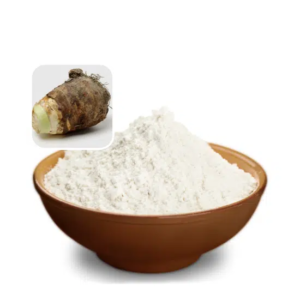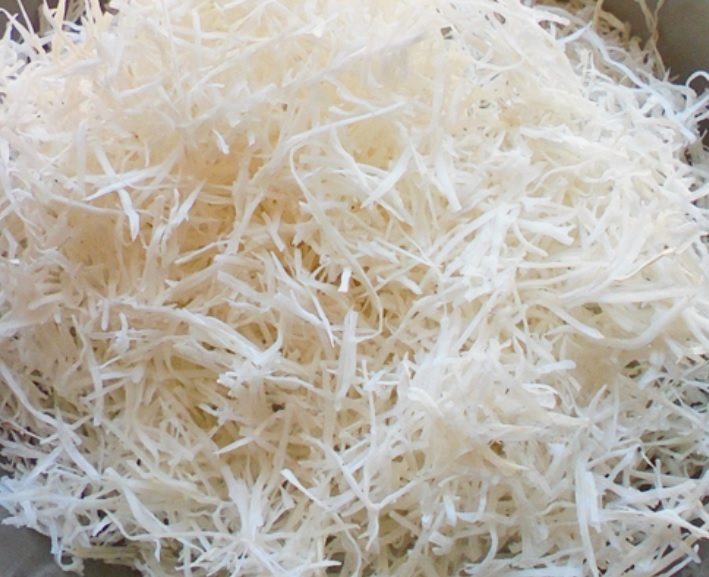

Description
Abacha African salad, also known as African Salad, is a traditional Nigerian dish that is particularly popular among the Igbo people of southeastern Nigeria. This vibrant and flavorful dish is made from shredded cassava tubers and is typically enjoyed as a snack, side dish, or even a main meal. Abacha is renowned for its unique taste and texture, combining a variety of ingredients to create a delicious and nutritious meal.
Ingredients and Components
- Abacha (Shredded Cassava)
- Description: Thinly sliced and dried cassava tubers.
- Preparation: Cassava is peeled, boiled, and then shredded or sliced thinly before being dried in the sun.
- Texture: Chewy and slightly firm.
- Role: Serves as the base of the salad, providing a starchy and slightly chewy texture.
- Ugba (Oil Bean Seeds)
- Description: Fermented African oil bean seeds.
- Flavor Profile: Earthy, nutty, and slightly bitter.
- Role: Adds a rich, earthy flavor and a chewy texture to the dish.
- Palm Oil
- Description: Thick, reddish-orange oil extracted from the fruit of the oil palm.
- Flavor Profile: Rich, buttery, and slightly nutty.
- Role: Provides a distinct flavor and color, and acts as the main oil for the dish.
- Crayfish
- Description: Dried and ground tiny shrimp or crayfish.
- Flavor Profile: Salty, fishy, and umami-rich.
- Role: Enhances the umami flavor of the dish.
- Pepper
- Description: Ground dry pepper or fresh pepper, typically Scotch bonnet or other hot varieties.
- Flavor Profile: Spicy and pungent.
- Role: Adds heat and spiciness.
- Ehuru (Calabash Nutmeg)
- Description: Ground seeds of the calabash nutmeg tree.
- Flavor Profile: Aromatic, slightly spicy, and nutty.
- Role: Adds a warm, nutty flavor and aroma.
- Onions
- Description: Sliced or chopped red or white onions.
- Flavor Profile: Sweet and slightly pungent.
- Role: Adds a crunchy texture and a sweet, pungent flavor.
- Utazi Leaves
- Description: Bitter green leaves.
- Flavor Profile: Bitter and slightly peppery.
- Role: Adds a contrasting bitter flavor and is often used as a garnish.
- Garden Eggs
- Description: Small, white or green eggplant-like vegetables.
- Flavor Profile: Slightly bitter and crunchy.
- Role: Adds a crunchy texture and a slightly bitter taste.
- Stockfish or Dry Fish
- Description: Dried and salted fish, often cod or similar fish.
- Flavor Profile: Salty and fishy.
- Role: Adds a rich, savory flavor and protein.
- Potash (Kaun)
- Description: A type of alkaline salt used as a tenderizer and emulsifier.
- Role: Helps to emulsify the palm oil and other ingredients, enhancing the texture.
Nutritional Profile (per serving)
- Calories: Approximately 250-400 kcal (varies based on portion size and ingredients)
- Carbohydrates: 30-50 grams
- Protein: 10-15 grams
- Fat: 10-20 grams
- Fiber: 5-10 grams
- Vitamins and Minerals: Rich in vitamins A and C, calcium, iron, and potassium.
Health Benefits
- Rich in Fiber: Promotes digestive health and helps maintain regular bowel movements.
- Source of Healthy Fats: Palm oil provides healthy fats, which are essential for various bodily functions.
- High in Protein: Ugba and stockfish contribute to the protein content, supporting muscle repair and growth.
- Vitamins and Minerals: Contains essential vitamins and minerals that support overall health and wellbeing.
- Antioxidants: Ingredients like crayfish and onions provide antioxidants, which help protect the body against oxidative stress.
Preparation and Cooking
- Preparation of Abacha:
- Soak and Drain: Soak the dried shredded cassava in cold water until soft, then drain.
- Blanching: Blanch the soaked cassava in hot water for a few minutes, then drain and set aside.
- Preparation of Ugba:
- Soak and Rinse: Soak the fermented oil bean seeds in warm water, rinse thoroughly to remove excess salt and impurities, then slice.
- Mixing the Ingredients:
- Combine: In a large bowl, combine the softened abacha, sliced ugba, crayfish, pepper, and onions.
- Add Palm Oil: Heat palm oil in a small pot, then dissolve a small amount of potash in water and add to the oil to thicken it. Pour the oil mixture over the abacha and mix thoroughly.
- Seasoning:
- Add Spices: Add ground ehuru, salt, and any additional seasonings to taste. Mix well.
- Incorporate Protein: Add flaked stockfish or dry fish and mix gently.
- Garnishing:
- Utazi Leaves: Garnish with sliced or torn utazi leaves for a bitter contrast.
- Garden Eggs: Optionally, garnish with sliced garden eggs for added texture and flavor.
Serving Suggestions
- Temperature: Can be served warm or at room temperature.
- Accompaniments: Often enjoyed with a side of fried fish, kpomo (cow skin), or beef. Some people also enjoy it with a chilled beverage.
- Presentation: Traditionally served on a flat plate or a banana leaf for an authentic touch.
Cultural and Historical Significance
- Igbo Cuisine: Abacha is a staple in Igbo culinary traditions, often prepared for special occasions, festivals, and celebrations.
- Symbol of Hospitality: Serving abacha is a gesture of hospitality and warmth in many Igbo communities.
- Festivals and Events: Commonly featured in local festivals, weddings, and community gatherings.
Safety and Precautions
- Cassava Preparation: Ensure cassava is properly processed to remove cyanogenic glycosides, which can be toxic if not adequately prepared.
- Allergies: Be aware of potential allergies to ingredients like crayfish or certain spices.
- Potash Usage: Use potash sparingly, as excessive consumption can have health implications.
also known as African Salad, is a traditional Nigerian dish that is particularly popular among the Igbo people of southeastern Nigeria. This vibrant and flavorful dish is made from shredded cassava tubers and is typically enjoyed as a snack, side dish, or even a main meal. Abacha is renowned for its unique taste and texture, combining a variety of ingredients to create a delicious and nutritious meal.
Ingredients and Components
- Abacha (Shredded Cassava)
- Description: Thinly sliced and dried cassava tubers.
- Preparation: Cassava is peeled, boiled, and then shredded or sliced thinly before being dried in the sun.
- Texture: Chewy and slightly firm.
- Role: Serves as the base of the salad, providing a starchy and slightly chewy texture.
- Ugba (Oil Bean Seeds)
- Description: Fermented African oil bean seeds.
- Flavor Profile: Earthy, nutty, and slightly bitter.
- Role: Adds a rich, earthy flavor and a chewy texture to the dish.
- Palm Oil
- Description: Thick, reddish-orange oil extracted from the fruit of the oil palm.
- Flavor Profile: Rich, buttery, and slightly nutty.
- Role: Provides a distinct flavor and color, and acts as the main oil for the dish.
- Crayfish
- Description: Dried and ground tiny shrimp or crayfish.
- Flavor Profile: Salty, fishy, and umami-rich.
- Role: Enhances the umami flavor of the dish.
- Pepper
- Description: Ground dry pepper or fresh pepper, typically Scotch bonnet or other hot varieties.
- Flavor Profile: Spicy and pungent.
- Role: Adds heat and spiciness.
- Ehuru (Calabash Nutmeg)
- Description: Ground seeds of the calabash nutmeg tree.
- Flavor Profile: Aromatic, slightly spicy, and nutty.
- Role: Adds a warm, nutty flavor and aroma.
- Onions
- Description: Sliced or chopped red or white onions.
- Flavor Profile: Sweet and slightly pungent.
- Role: Adds a crunchy texture and a sweet, pungent flavor.
- Utazi Leaves
- Description: Bitter green leaves.
- Flavor Profile: Bitter and slightly peppery.
- Role: Adds a contrasting bitter flavor and is often used as a garnish.
- Garden Eggs
- Description: Small, white or green eggplant-like vegetables.
- Flavor Profile: Slightly bitter and crunchy.
- Role: Adds a crunchy texture and a slightly bitter taste.
- Stockfish or Dry Fish
- Description: Dried and salted fish, often cod or similar fish.
- Flavor Profile: Salty and fishy.
- Role: Adds a rich, savory flavor and protein.
- Potash (Kaun)
- Description: A type of alkaline salt used as a tenderizer and emulsifier.
- Role: Helps to emulsify the palm oil and other ingredients, enhancing the texture.
Nutritional Profile (per serving)
- Calories: Approximately 250-400 kcal (varies based on portion size and ingredients)
- Carbohydrates: 30-50 grams
- Protein: 10-15 grams
- Fat: 10-20 grams
- Fiber: 5-10 grams
- Vitamins and Minerals: Rich in vitamins A and C, calcium, iron, and potassium.
Health Benefits
- Rich in Fiber: Promotes digestive health and helps maintain regular bowel movements.
- Source of Healthy Fats: Palm oil provides healthy fats, which are essential for various bodily functions.
- High in Protein: Ugba and stockfish contribute to the protein content, supporting muscle repair and growth.
- Vitamins and Minerals: Contains essential vitamins and minerals that support overall health and wellbeing.
- Antioxidants: Ingredients like crayfish and onions provide antioxidants, which help protect the body against oxidative stress.
Preparation and Cooking
- Preparation of Abacha:
- Soak and Drain: Soak the dried shredded cassava in cold water until soft, then drain.
- Blanching: Blanch the soaked cassava in hot water for a few minutes, then drain and set aside.
- Preparation of Ugba:
- Soak and Rinse: Soak the fermented oil bean seeds in warm water, rinse thoroughly to remove excess salt and impurities, then slice.
- Mixing the Ingredients:
- Combine: In a large bowl, combine the softened abacha, sliced ugba, crayfish, pepper, and onions.
- Add Palm Oil: Heat palm oil in a small pot, then dissolve a small amount of potash in water and add to the oil to thicken it. Pour the oil mixture over the abacha and mix thoroughly.
- Seasoning:
- Add Spices: Add ground ehuru, salt, and any additional seasonings to taste. Mix well.
- Incorporate Protein: Add flaked stockfish or dry fish and mix gently.
- Garnishing:
- Utazi Leaves: Garnish with sliced or torn utazi leaves for a bitter contrast.
- Garden Eggs: Optionally, garnish with sliced garden eggs for added texture and flavor.
Serving Suggestions
- Temperature: Can be served warm or at room temperature.
- Accompaniments: Often enjoyed with a side of fried fish, kpomo (cow skin), or beef. Some people also enjoy it with a chilled beverage.
- Presentation: Traditionally served on a flat plate or a banana leaf for an authentic touch.
Cultural and Historical Significance
- Igbo Cuisine: Abacha is a staple in Igbo culinary traditions, often prepared for special occasions, festivals, and celebrations.
- Symbol of Hospitality: Serving abacha is a gesture of hospitality and warmth in many Igbo communities.
- Festivals and Events: Commonly featured in local festivals, weddings, and community gatherings.
Safety and Precautions
- Cassava Preparation: Ensure cassava is properly processed to remove cyanogenic glycosides, which can be toxic if not adequately prepared.
- Allergies: Be aware of potential allergies to ingredients like crayfish or certain spices.
- Potash Usage: Use potash sparingly, as excessive consumption can have health implications.
Related products
-
Sale!

500g black pepper powder
₦10,000.00Original price was: ₦10,000.00.₦9,000.00Current price is: ₦9,000.00. Add to cart -
Sale!

100g of Achi soup thickner
₦2,500.00Original price was: ₦2,500.00.₦2,000.00Current price is: ₦2,000.00. Add to cart -
Sale!

2kg of Cocoyam powder
₦40,000.00Original price was: ₦40,000.00.₦36,000.00Current price is: ₦36,000.00. Add to cart -
Sale!

1 Paint of Dates
₦14,000.00Original price was: ₦14,000.00.₦13,000.00Current price is: ₦13,000.00. Add to cart


Reviews
There are no reviews yet.